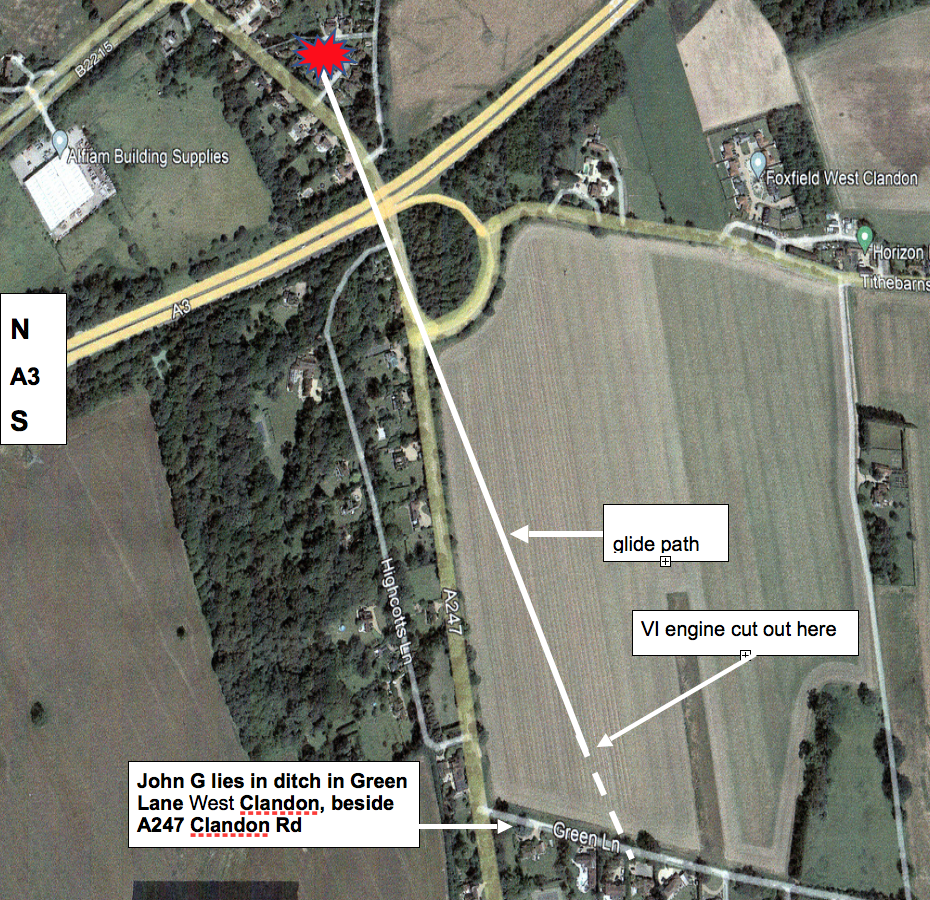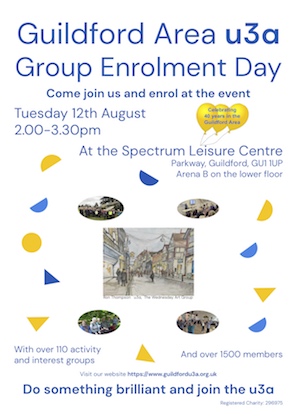 Abraham Lincoln
If given the truth, the people can be depended upon to meet any national crisis...
Abraham Lincoln
If given the truth, the people can be depended upon to meet any national crisis...
 Guildford news...
for Guildford people, brought to you by Guildford reporters - Guildford's own news service
Guildford news...
for Guildford people, brought to you by Guildford reporters - Guildford's own news service
Recalling A VI Flying Bomb That Fell On A House In Send With Fatal Consequences
Published on: 13 Mar, 2022
Updated on: 14 Mar, 2022
John Glanfield recalls an incident during the Second World War when a VI flying bomb fell on a house at Burnt Common, Send in which several members of a family were killed.
I was an 11-year old schoolboy cycling home for lunch when the war caught up with me in Green Lane, West Clandon, on Monday, August 21, 1944.
The unforgettable burbling engine note of an approaching V1 Doodlebug sped me into a nearby ditch. Its pulsejet cut out almost above me. The silent glide lasted eight to 10 interminable seconds before its 1,870 lb amatol warhead blew up. I watched a broad and near black column of smoke boiling upwards beyond distant trees to the sound of much breaking glass.
The V1 had impacted some 1,100 yds away on the council estate at Burnt Common, Send.

Using a modern aerial map, John Glanfield has marked the flight of the V1 flying bomb, where it landed and his position as he watched it come down. Click image to enlarge in a new window.
Tragically, four members of one family died*. Mr and Mrs Privett and their daughters Violet, aged 21 years, and Joyce, three and a half years. Numerous others were injured.
The Surrey Advertiser was prohibited from identifying locations, but guardedly reported that “some houses were demolished and the others were badly damaged”. The blast also flattened Messrs Fogwills’ many greenhouses nearby, hence the prolonged noise of shattering glass that reached me.
Harry Snell’s eight-man Heavy Rescue Service team, based at Surrey County Council’s Merrow rail-side depot, received a call at 1.15pm to attend the incident.**
On arrival they began a harrowing search for the Privetts. Salvage work followed until the squad had secured the site before leaving at 7.30pm. This was the first of several V1 strikes around Send over the next few days.
My younger brother Dick and I later cycled over to a bomb site behind Messrs Colbornes, motor dealers on the A3 between Send and Ripley. We hoped for a handful of shrapnel.
Instead we came away with a large section of the V1’s olive-green light alloy fuselage and a couple of feet of the jet pipe’s core.
After hiding our bikes we triumphantly bore our trophies home on a smashed gate along the utterly deserted A3.
A little short of the Jovial Sailor pub however, the village policeman overtook us on his bike. Not unreasonably, he asked what we thought we were doing. Having given a somewhat flawed explanation, we were sternly commanded to return our cargo whence it came.
There followed a discreet interval after he pedalled away before we heaved the lot over someone’s garden fence. It must have given them a war story to cherish.
A third Doodlebug fell around this time. It struck some 250 yards north of the first, in Send Barns Lane near the turn-in to The Pathway which was then an open field bordering the lane. A big roadside oak was lost and there would have been some local blast damage, but I believe nobody was injured. Dick and I steered clear of that site after our challenging brush with the law.
.* David Rose adds: Send & Ripley History Society’s book, Memories of War (published in 2009) is a collection of Second World War recollections by local people. It includes those of Gilbert Privett, whose parents and two of his sisters died, as John Glanfield mentions.
In the book it states that Gilbert, who at the time was working for Gibbs, an agricultural machinery firm, was cycling home for lunch and was first on the scene. He remembers climbing over the rubble of his house looking for his family. His other siblings, two younger brothers and a sister, were unharmed as they had had lunch at school.
** Source. Joan Iselle, Stringers Avenue, Jacobs Well. Her father Harold Snell was ‘ganger’ (lLeader) of the Heavy Rescue Service which attended.
Responses to Recalling A VI Flying Bomb That Fell On A House In Send With Fatal Consequences
Leave a Comment Cancel reply
Please see our comments policy. All comments are moderated and may take time to appear. Full names, or at least initial and surname, must be given.
Click on cartoon for Dragon story: Public Asked for Views on SCC’s Proposal for Reduced Speed Limits


Recent Articles
- Police Investigating Wildlife Attacks At Fleet Pond Issue Three E-fits
- Wildlife Conservation Project Seeks To Protect Some of Surrey’s Rarest Habitats
- Dragon Interview: What’s Reform Guildford’s View of Local Government Reorganisation?
- ‘Astonishingly Clever’ SCC Show Garden Wins Silver for Turning Parking Spaces Green
- New Air Quality Strategy to Improve Pollution Approved by Guildford Borough Council
- Co-founder of Surrey Pride Found Guilty of Rape of 12-year-old Boy
- July By-elections To Show Relative Standings of Political Parties
- Birdwatcher’s Diary No.330 Bempton Cliffs
- Notice: Invisible Things at Guildford House – July 5 to September 27
- GBC Asks Residents for Views on Its Draft Building Height Guidance


Recent Comments
- Sara Tokunaga on Letter: A Simple Footbridge Should Have Been Affordable to Keep Towpath Over Weir Open
- Paul Crosthwaite on Hitting The Guildford Music Scene In The Sixties With Blues Band The Crow Janes
- Paul Robinson on Letter: A Simple Footbridge Should Have Been Affordable to Keep Towpath Over Weir Open
- Paul Gorton on Public Asked for Views on SCC’s Proposal for Reduced Speed Limits
- Jim Allen on GBC Asks Residents for Views on Its Draft Building Height Guidance
- D Bisdee on Drivers Caught in Yellow Box Junctions at the Dennis Roundabout Paid £81k to SCC
Search in Site
Media Gallery
Dragon Interview: Local Artist Leaves Her Mark At One of England’s Most Historic Buildings
January 21, 2023 / No Comment / Read MoreDragon Interview: Lib Dem Planning Chair: ‘Current Policy Doesn’t Work for Local People’
January 19, 2023 / No Comment / Read MoreA3 Tunnel in Guildford ‘Necessary’ for New Homes, Says Guildford’s MP
January 10, 2023 / No Comment / Read More‘Madness’ for London Road Scheme to Go Ahead Against ‘Huge Opposition’, Says SCC Leader
January 6, 2023 / No Comment / Read MoreCouncillor’s Son Starts Campaign for More Consultation on North Street Plan
December 30, 2022 / No Comment / Read MoreCounty Council Climbs Down Over London Road Works – Further ‘Engagement’ Period Announced
December 14, 2022 / No Comment / Read MoreDragon Interview: GBC Reaction to the Government’s Expected Decision to Relax Housing Targets
December 7, 2022 / No Comment / Read MoreHow Can Our Town Centre Businesses Recover? Watch the Shop Front Debate
May 18, 2020 / No Comment / Read More






John Lomas
March 14, 2022 at 12:33 pm
There have been many explanations/theories why the press didn’t report locations, or even in some cases misreported them.
V1s falling in London were often reported as having fallen well beyond their actual location and the turned German spies then reported this to their “masters” which resulted in shorter ranges being used for subsequent shoots.
The Burnt Common bomb may have been intended for Weybridge or Woking and a report from an uncaptured spy could have caused them to change their heading and range.
David Bailey
March 14, 2022 at 2:40 pm
During 2020, I was in contact with Suzanne Rico, a journalist in the USA whose grandfather was Robert Lusser, a German aeronautical engineer and chief designer of the V1 (Vergeltungswaffe).
After the war, in the USA, he worked with Werner Von Braun at Alabama’s Redstone Arsenal. Unfortunately, after several emails we lost contact.
David Rose adds: Hi David, as you’ll remember I was also in contact with Suzanne and helping her a little with her project. Her quest to obtain recordings of people giving their memories of V1 flying bombs was made difficult due to the pandemic’s lockdowns. However, I recorded my father in law with his memories of a V1 that fell on a school at Enfield, and which she was very grateful for.
Derek James Maskell
March 14, 2022 at 3:54 pm
There was also one that landed at Burnt Common. It hit a house and killed some occupants. My mother lived in the house opposite and saw it come over. When the engine stopped she had a premonition of where it would land and she was right.
David Rose adds: This is the incident John has written about and is stated at the start of the story.
Allen Mead
March 15, 2022 at 1:13 pm
I can add to Derek’s comment as we are cousins. My Aunt Marg, who was a teenager living in the house opposite to the Privett family that got a direct hit, rescued my brother off his potty before the wall came down and my father who was on leave from the navy had not long got out of the seat by the wall that came down. He always said after that he felt safer at sea than on land, despite having been in the Atlantic convoys and helping with the D Day landings.
My brother always claimed Aunt Marg, who is 90 now, was his heroine.
My family that lived opposite were called Turner.
Donald Roy Green
June 19, 2022 at 7:23 pm
I was a 12-year-old schoolboy in 1944 and remember this.
I also have a recollection of one landing in Egley Road, Woking (before all the houses were built) but have been unable to confirm this.
I was out fishing near Newark Mill and saw it go over. Whether this was the Burnt Common incident or Egley Road, I don’t know.
Frank Phillipson
June 20, 2022 at 12:43 am
V1 Egley Road, July 24 1944. Police records of incident:
“Surrey Police Daybook Record: – 24th July 1944, 21:40, Flying bomb on cultivated ground, approx. 300yds NW of Egley Farm, Mayford, MR 437765, & 75yds SE of Southern Railway Portsmouth Line. No casualties. Damage to telephone wires along line. Devastation to 2 acres of growing carrots, property of Mr Jackman.
“Surrey Police Daybook Record (Updated): – 24th July 1944, 21:40, Flying bomb in nursery ground, approximately 300yds NW of Egley Farm, Mayford & 75yds SE of Southern Railway Portsmouth Line, MR 437765. 1 slight female casualty. Damage to telephone wires on the railway. 90 properties suffered minor damage, extensive glass damage to 5 nursery glass houses, damage to valuable flowering shrubs & ¾ acre of carrots owned by Jackman’s Nursery Woking & also damage to growing tomatoes at Egley Farm Nurseries, Woking.”